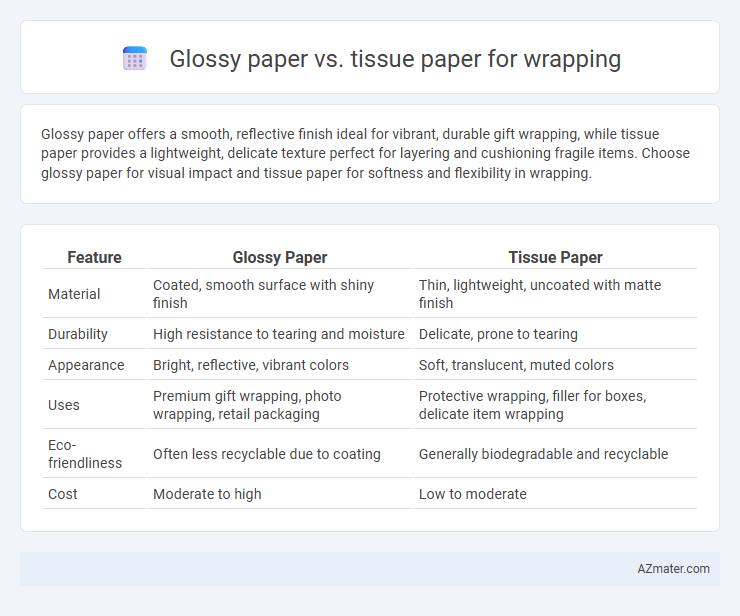Glossy paper offers a smooth, reflective finish ideal for vibrant, durable gift wrapping, while tissue paper provides a lightweight, delicate texture perfect for layering and cushioning fragile items. Choose glossy paper for visual impact and tissue paper for softness and flexibility in wrapping.
Table of Comparison
| Feature | Glossy Paper | Tissue Paper |
|---|---|---|
| Material | Coated, smooth surface with shiny finish | Thin, lightweight, uncoated with matte finish |
| Durability | High resistance to tearing and moisture | Delicate, prone to tearing |
| Appearance | Bright, reflective, vibrant colors | Soft, translucent, muted colors |
| Uses | Premium gift wrapping, photo wrapping, retail packaging | Protective wrapping, filler for boxes, delicate item wrapping |
| Eco-friendliness | Often less recyclable due to coating | Generally biodegradable and recyclable |
| Cost | Moderate to high | Low to moderate |
Introduction to Wrapping Materials
Glossy paper offers a smooth, shiny finish that enhances the visual appeal of wrapped gifts, making it ideal for elegant and formal occasions. Tissue paper provides a lightweight, delicate texture that adds a soft, layered effect, perfect for cushioning fragile items or creating volume in gift packaging. Both materials serve distinct roles in wrapping, with glossy paper emphasizing aesthetics and tissue paper prioritizing protection and subtlety.
What is Glossy Paper?
Glossy paper is a type of wrapping paper characterized by its smooth, shiny surface that enhances color vibrancy and provides a premium appearance. It is coated with a layer of gloss finish, making it more durable and resistant to moisture compared to tissue paper. Glossy paper is ideal for gift wrapping when a polished, elegant presentation is desired, while tissue paper offers a softer, delicate touch for layering or cushioning.
What is Tissue Paper?
Tissue paper is a lightweight, thin paper often used for delicate wrapping, cushioning, and adding a soft touch to packaged items. It is semi-transparent and easily folds or crumples, making it ideal for protecting fragile products and providing an elegant presentation. Unlike glossy paper, tissue paper absorbs ink and moisture better, offering a matte finish suitable for decorative layering inside gift boxes or bags.
Visual Appeal: Glossy Paper vs Tissue Paper
Glossy paper offers a vibrant, reflective surface that enhances colors and provides a sleek, polished look, making it ideal for high-impact gift wrapping. Tissue paper delivers a soft, delicate appearance with a matte finish that adds a subtle elegance and layering effect to presents. Choosing between glossy and tissue paper depends on the desired visual appeal, with glossy paper emphasizing brightness and smoothness, while tissue paper highlights texture and understated charm.
Durability and Protection
Glossy paper offers superior durability and moisture resistance compared to tissue paper, making it ideal for protecting fragile items during wrapping. Tissue paper, while lightweight and flexible, lacks the strength to guard against tears or external pressure, resulting in less reliable protection. For wrapping that demands enhanced durability and safeguarding, glossy paper provides a more robust and resilient option.
Environmental Impact and Sustainability
Glossy paper often contains plastic coatings and chemical treatments that hinder recyclability, contributing to greater environmental harm compared to tissue paper. Tissue paper is typically biodegradable and made from recycled fibers, making it a more sustainable choice for wrapping with lower carbon footprint and easier decomposition. Choosing tissue paper supports eco-friendly packaging practices by reducing landfill waste and conserving natural resources.
Cost Comparison
Glossy paper typically costs more than tissue paper due to its thicker material and vibrant finish, making it a premium choice for gift wrapping. Tissue paper is more affordable and often purchased in bulk, ideal for budget-conscious consumers who need large quantities for packaging or decorative purposes. While glossy paper adds a luxurious touch, tissue paper offers cost-effective flexibility without compromising the presentation.
Versatility and Usage Scenarios
Glossy paper offers a sleek, reflective surface ideal for elegant gift wrapping and retail packaging, making it suitable for formal occasions, promotional events, and high-end product presentations. Tissue paper provides a lightweight, flexible option that excels in protecting delicate items, layering in gift bags, and adding texture to craft projects, perfect for informal or decorative uses. Both papers serve distinct roles: glossy paper emphasizes visual impact and durability, while tissue paper prioritizes softness and cushioning.
Printing and Customization Options
Glossy paper offers vibrant color reproduction and sharp image quality, making it ideal for high-resolution printing and detailed logos in wrapping applications. Tissue paper, while more delicate and translucent, supports subtle prints and can be customized with soft, muted tones or patterns, enhancing the unwrapping experience. Both materials accommodate various printing techniques, but glossy paper excels in durability and visual impact, whereas tissue paper is preferred for lightweight, eco-friendly packaging designs.
Choosing the Right Wrapping Paper
Glossy paper offers a sleek, vibrant finish ideal for presenting gifts with a polished, elegant look, while tissue paper provides a soft, lightweight option perfect for delicate items and adding texture. Choosing the right wrapping paper depends on the occasion and the type of gift; glossy paper is better suited for formal events and sturdy packages, whereas tissue paper excels in layering and cushioning fragile contents. Consider durability, aesthetic appeal, and the recipient's preferences to select the optimal wrapping material for a memorable presentation.

Infographic: Glossy paper vs Tissue paper for Wrapping
 azmater.com
azmater.com